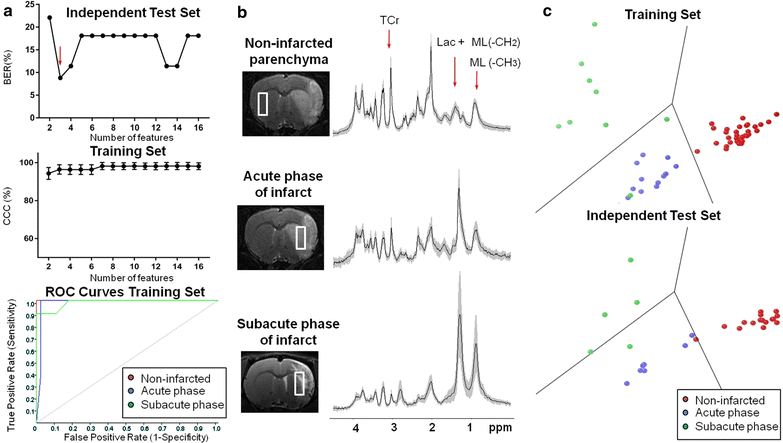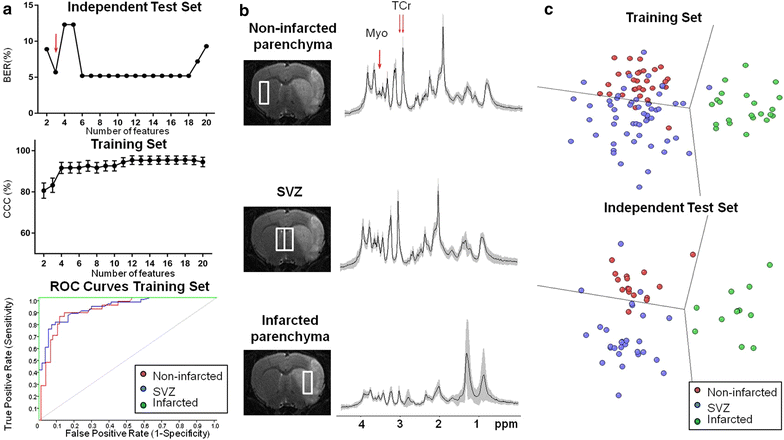Brain metabolic pattern analysis using a magnetic resonance spectra classification software in experimental stroke
- PMID: 28086802
- PMCID: PMC5237280
- DOI: 10.1186/s12868-016-0328-x
Brain metabolic pattern analysis using a magnetic resonance spectra classification software in experimental stroke
Abstract
Background: Magnetic resonance spectroscopy (MRS) provides non-invasive information about the metabolic pattern of the brain parenchyma in vivo. The SpectraClassifier software performs MRS pattern-recognition by determining the spectral features (metabolites) which can be used objectively to classify spectra. Our aim was to develop an Infarct Evolution Classifier and a Brain Regions Classifier in a rat model of focal ischemic stroke using SpectraClassifier.
Results: A total of 164 single-voxel proton spectra obtained with a 7 Tesla magnet at an echo time of 12 ms from non-infarcted parenchyma, subventricular zones and infarcted parenchyma were analyzed with SpectraClassifier ( http://gabrmn.uab.es/?q=sc ). The spectra corresponded to Sprague-Dawley rats (healthy rats, n = 7) and stroke rats at day 1 post-stroke (acute phase, n = 6 rats) and at days 7 ± 1 post-stroke (subacute phase, n = 14). In the Infarct Evolution Classifier, spectral features contributed by lactate + mobile lipids (1.33 ppm), total creatine (3.05 ppm) and mobile lipids (0.85 ppm) distinguished among non-infarcted parenchyma (100% sensitivity and 100% specificity), acute phase of infarct (100% sensitivity and 95% specificity) and subacute phase of infarct (78% sensitivity and 100% specificity). In the Brain Regions Classifier, spectral features contributed by myoinositol (3.62 ppm) and total creatine (3.04/3.05 ppm) distinguished among infarcted parenchyma (100% sensitivity and 98% specificity), non-infarcted parenchyma (84% sensitivity and 84% specificity) and subventricular zones (76% sensitivity and 93% specificity).
Conclusion: SpectraClassifier identified candidate biomarkers for infarct evolution (mobile lipids accumulation) and different brain regions (myoinositol content).
Keywords: Animal model; Magnetic resonance spectroscopy; Metabolomics; Pattern recognition; Stroke.
Figures


Similar articles
-
Brain choline concentration. Early quantitative marker of ischemia and infarct expansion?Neurology. 2010 Sep 7;75(10):850-6. doi: 10.1212/WNL.0b013e3181f11bf1. Neurology. 2010. PMID: 20819997
-
Spectroscopic assessment of alterations in macromolecule and small-molecule metabolites in human brain after stroke.Stroke. 2001 Dec 1;32(12):2797-802. doi: 10.1161/hs1201.099414. Stroke. 2001. PMID: 11739976 Clinical Trial.
-
Correlation between lactate and neuronal cell damage in the rat brain after focal ischemia: An in vivo 1H magnetic resonance spectroscopic (1H-MRS) study.Acta Radiol. 2010 Apr;51(3):344-50. doi: 10.3109/02841850903515395. Acta Radiol. 2010. PMID: 20144147
-
N-acetylaspartate decrease in acute stage of ischemic stroke: a perspective from experimental and clinical studies.Magn Reson Med Sci. 2015;14(1):13-24. doi: 10.2463/mrms.2014-0039. Epub 2014 Dec 15. Magn Reson Med Sci. 2015. PMID: 25500779 Review.
-
MR spectroscopy in stroke.Br Med Bull. 2000;56(2):334-45. doi: 10.1258/0007142001903256. Br Med Bull. 2000. PMID: 11092084 Review.
Cited by
-
The pattern of brain metabolism in chronic steno-occlusive cerebral artery disease.Ann Transl Med. 2022 Sep;10(18):1003. doi: 10.21037/atm-22-3993. Ann Transl Med. 2022. PMID: 36267716 Free PMC article.
-
NAC and Vitamin D Restore CNS Glutathione in Endotoxin-Sensitized Neonatal Hypoxic-Ischemic Rats.Antioxidants (Basel). 2021 Mar 20;10(3):489. doi: 10.3390/antiox10030489. Antioxidants (Basel). 2021. PMID: 33804757 Free PMC article.
-
Metabolomic Recovery as a Result of Ischemic Preconditioning Was More Pronounced in Hippocampus than in Cortex That Appeared More Sensitive to Metabolomic Blood Components.Metabolites. 2021 Aug 5;11(8):516. doi: 10.3390/metabo11080516. Metabolites. 2021. PMID: 34436457 Free PMC article.
References
-
- Stefan D, Di Cesare F, Andrasescu A, Popa E, Lazariev A, Vescovo E, et al. Quantitation of magnetic resonance spectroscopy signals: the jMRUI software package. Meas Sci Technol. 2009;20:10. doi: 10.1088/0957-0233/20/10/104035. - DOI
Publication types
MeSH terms
Substances
LinkOut - more resources
Full Text Sources
Other Literature Sources
Medical

